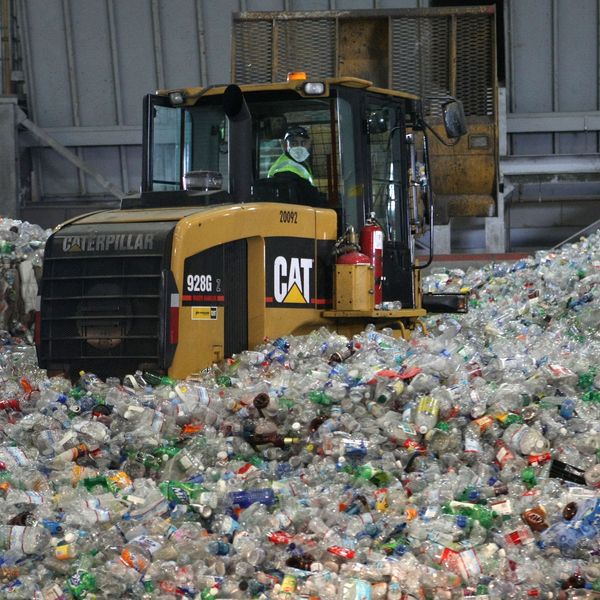It's Time to Protect Consumers from Toxic Chemicals
Because BPA is in canned food and receipts and on our money, it's virtually impossible to avoid.
When most people hear the word "hormones," they have a flashback to high school science class or think of their adolescent children. But rarely do we think about staples of our everyday lives such as receipts, water bottles, and baby bottles. So what do hormones have to do with a host of consumer products?
It turns out there are three sources for hormones. They can naturally occur in our bodies, or you can wind up with them inadvertently through prescription drugs or consumer products. Yes, that's right--consumer products.
The chemical bisphenol A (generally referred to as BPA) has caught the public's attention recently, mainly due to its use in baby bottles, sippy cups, and canned food. BPA is a chemical that acts like a hormone, mimicking estrogen in our bodies. According to the Centers for Disease Control (CDC), over 93 percent of Americans have BPA in their bodies at levels that have shown to cause harm in laboratory studies.
By mimicking naturally occurring hormones, BPA can disrupt the body's normal functions. Because of this, it has been linked to a host of health effects: breast and prostate cancer, insulin resistance, early onset of puberty, and ADD/ADHD, as well as disrupting thyroid function and the body's production of other hormones.
A recent study by Safer Chemicals, Healthy Families and the Washington Toxics Coalition called "On the Money" found that large amounts of BPA were found in receipts, which can transfer the chemical onto our skin. Even if you handle receipts carefully, they're contaminating the money we use everyday, making it virtually impossible to avoid BPA exposure.
So how did we get here? How is it that every day there seems to be a new chemical--in a different product--that could harm us? Unfortunately, our federal system for overseeing chemical safety is sorely broken. Last updated in the 1970s, our federal laws fail to ensure chemicals are safe before they end up on the market. The result has been widespread exposure to toxic chemicals in our homes.
There's formaldehyde in wrinkle-free clothes, lead in children's toys, BPA in receipts--the list is endless. For a consumer, it can be very overwhelming--what's safe to use and what's not? The good news is that there's a solution to the problem that doesn't involve buying more expensive products or having to carry a "products-to-avoid" list to your local retailer.
In the last session of Congress, champions of this issue introduced a bill that would require the government to update federal law governing chemicals in consumer products. The Safe Chemicals Act of 2010 (S 3209/ HR 5820) would take the burden off consumers and would instead require companies to ensure chemicals are safe before they enter our workplaces and homes. Even with the new political landscape, I'm hopeful that this new Congress will put commonsense limits on toxic chemicals.
We're all exposed to chemicals that act like hormones. We should collectively work toward a future where the only hormones in our bodies are those that our bodies naturally produce. I encourage you to call your members of Congress to ask them to support the Safe Chemicals Act in 2011. With leadership from our federal government, we can ensure that commonsense limits on toxic chemicals protect our families and health.
An Urgent Message From Our Co-Founder
Dear Common Dreams reader, The U.S. is on a fast track to authoritarianism like nothing I've ever seen. Meanwhile, corporate news outlets are utterly capitulating to Trump, twisting their coverage to avoid drawing his ire while lining up to stuff cash in his pockets. That's why I believe that Common Dreams is doing the best and most consequential reporting that we've ever done. Our small but mighty team is a progressive reporting powerhouse, covering the news every day that the corporate media never will. Our mission has always been simple: To inform. To inspire. And to ignite change for the common good. Now here's the key piece that I want all our readers to understand: None of this would be possible without your financial support. That's not just some fundraising cliche. It's the absolute and literal truth. We don't accept corporate advertising and never will. We don't have a paywall because we don't think people should be blocked from critical news based on their ability to pay. Everything we do is funded by the donations of readers like you. Will you donate now to help power the nonprofit, independent reporting of Common Dreams? Thank you for being a vital member of our community. Together, we can keep independent journalism alive when it’s needed most. - Craig Brown, Co-founder |
When most people hear the word "hormones," they have a flashback to high school science class or think of their adolescent children. But rarely do we think about staples of our everyday lives such as receipts, water bottles, and baby bottles. So what do hormones have to do with a host of consumer products?
It turns out there are three sources for hormones. They can naturally occur in our bodies, or you can wind up with them inadvertently through prescription drugs or consumer products. Yes, that's right--consumer products.
The chemical bisphenol A (generally referred to as BPA) has caught the public's attention recently, mainly due to its use in baby bottles, sippy cups, and canned food. BPA is a chemical that acts like a hormone, mimicking estrogen in our bodies. According to the Centers for Disease Control (CDC), over 93 percent of Americans have BPA in their bodies at levels that have shown to cause harm in laboratory studies.
By mimicking naturally occurring hormones, BPA can disrupt the body's normal functions. Because of this, it has been linked to a host of health effects: breast and prostate cancer, insulin resistance, early onset of puberty, and ADD/ADHD, as well as disrupting thyroid function and the body's production of other hormones.
A recent study by Safer Chemicals, Healthy Families and the Washington Toxics Coalition called "On the Money" found that large amounts of BPA were found in receipts, which can transfer the chemical onto our skin. Even if you handle receipts carefully, they're contaminating the money we use everyday, making it virtually impossible to avoid BPA exposure.
So how did we get here? How is it that every day there seems to be a new chemical--in a different product--that could harm us? Unfortunately, our federal system for overseeing chemical safety is sorely broken. Last updated in the 1970s, our federal laws fail to ensure chemicals are safe before they end up on the market. The result has been widespread exposure to toxic chemicals in our homes.
There's formaldehyde in wrinkle-free clothes, lead in children's toys, BPA in receipts--the list is endless. For a consumer, it can be very overwhelming--what's safe to use and what's not? The good news is that there's a solution to the problem that doesn't involve buying more expensive products or having to carry a "products-to-avoid" list to your local retailer.
In the last session of Congress, champions of this issue introduced a bill that would require the government to update federal law governing chemicals in consumer products. The Safe Chemicals Act of 2010 (S 3209/ HR 5820) would take the burden off consumers and would instead require companies to ensure chemicals are safe before they enter our workplaces and homes. Even with the new political landscape, I'm hopeful that this new Congress will put commonsense limits on toxic chemicals.
We're all exposed to chemicals that act like hormones. We should collectively work toward a future where the only hormones in our bodies are those that our bodies naturally produce. I encourage you to call your members of Congress to ask them to support the Safe Chemicals Act in 2011. With leadership from our federal government, we can ensure that commonsense limits on toxic chemicals protect our families and health.
When most people hear the word "hormones," they have a flashback to high school science class or think of their adolescent children. But rarely do we think about staples of our everyday lives such as receipts, water bottles, and baby bottles. So what do hormones have to do with a host of consumer products?
It turns out there are three sources for hormones. They can naturally occur in our bodies, or you can wind up with them inadvertently through prescription drugs or consumer products. Yes, that's right--consumer products.
The chemical bisphenol A (generally referred to as BPA) has caught the public's attention recently, mainly due to its use in baby bottles, sippy cups, and canned food. BPA is a chemical that acts like a hormone, mimicking estrogen in our bodies. According to the Centers for Disease Control (CDC), over 93 percent of Americans have BPA in their bodies at levels that have shown to cause harm in laboratory studies.
By mimicking naturally occurring hormones, BPA can disrupt the body's normal functions. Because of this, it has been linked to a host of health effects: breast and prostate cancer, insulin resistance, early onset of puberty, and ADD/ADHD, as well as disrupting thyroid function and the body's production of other hormones.
A recent study by Safer Chemicals, Healthy Families and the Washington Toxics Coalition called "On the Money" found that large amounts of BPA were found in receipts, which can transfer the chemical onto our skin. Even if you handle receipts carefully, they're contaminating the money we use everyday, making it virtually impossible to avoid BPA exposure.
So how did we get here? How is it that every day there seems to be a new chemical--in a different product--that could harm us? Unfortunately, our federal system for overseeing chemical safety is sorely broken. Last updated in the 1970s, our federal laws fail to ensure chemicals are safe before they end up on the market. The result has been widespread exposure to toxic chemicals in our homes.
There's formaldehyde in wrinkle-free clothes, lead in children's toys, BPA in receipts--the list is endless. For a consumer, it can be very overwhelming--what's safe to use and what's not? The good news is that there's a solution to the problem that doesn't involve buying more expensive products or having to carry a "products-to-avoid" list to your local retailer.
In the last session of Congress, champions of this issue introduced a bill that would require the government to update federal law governing chemicals in consumer products. The Safe Chemicals Act of 2010 (S 3209/ HR 5820) would take the burden off consumers and would instead require companies to ensure chemicals are safe before they enter our workplaces and homes. Even with the new political landscape, I'm hopeful that this new Congress will put commonsense limits on toxic chemicals.
We're all exposed to chemicals that act like hormones. We should collectively work toward a future where the only hormones in our bodies are those that our bodies naturally produce. I encourage you to call your members of Congress to ask them to support the Safe Chemicals Act in 2011. With leadership from our federal government, we can ensure that commonsense limits on toxic chemicals protect our families and health.

